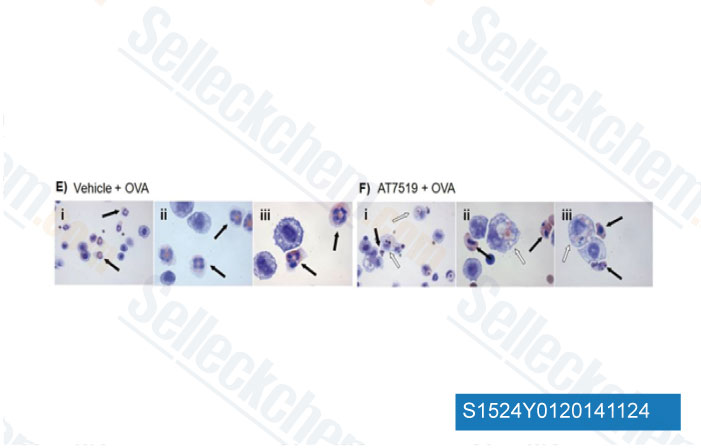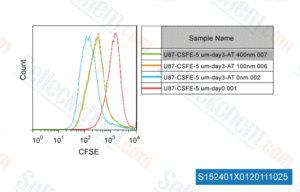|
Toll Free: (877) 796-6397 -- USA and Canada only -- |
Fax: +1-832-582-8590 Orders: +1-832-582-8158 |
Tech Support: +1-832-582-8158 Ext:3 Please provide your Order Number in the email. |
Technical Data
| Formula | C16H17Cl2N5O2 |
||||||
| Molecular Weight | 382.24 | CAS No. | 844442-38-2 | ||||
| Solubility (25°C)* | In vitro | DMSO | 10 mg/mL (26.16 mM) | ||||
| Water | Insoluble | ||||||
| Ethanol | Insoluble | ||||||
| In vivo (Add solvents to the product individually and in order) |
|
||||||
|
* <1 mg/ml means slightly soluble or insoluble. * Please note that Selleck tests the solubility of all compounds in-house, and the actual solubility may differ slightly from published values. This is normal and is due to slight batch-to-batch variations. * Room temperature shipping (Stability testing shows this product can be shipped without any cooling measures.) |
|||||||
Preparing Stock Solutions
Biological Activity
| Description | AT7519 is a multi-CDK inhibitor for CDK1, 2, 4, 6 and 9 with IC50 of 10-210 nM. It is less potent to CDK3 and little active to CDK7. This compound also decrease GSK3β phosphorylation. It induces apoptosis. Phase 2. | |||||||||||
|---|---|---|---|---|---|---|---|---|---|---|---|---|
| Targets |
|
|||||||||||
| In vitro | AT7519 is an ATP competitive CDK inhibitor with a Ki value of 38 nM for CDK1. This compound is inactive against all non-CDK kinases with the exception of GSK3β (IC50 = 89 nM). It shows potent antiproliferative activity in a variety of human tumor cell lines with IC50 values ranging from 40 nM for MCF-7 to 940 nM for SW620 consistent with the inhibition of CDK1 and CDK2. [1] This chemical induces dose-dependent cytotoxicity in multiple myeloma (MM) cell lines with IC50 values ranging from 0.5 to 2 μM at 48 hours, with the most sensitive cell lines being MM.1S (0.5 μM) and U266 (0.5 μM) and the most resistant MM.1R (>2 μM). It does not induce cytotoxicity in peripheral blood mononuclear cells (PBMNC). This inhibitor partially overcomes the proliferative advantage conferred by IL6 and IGF-1 as well as the protective effect of bone marrow stromal cells (BMSCs). It induces rapid dephosphorylation of RNA pol II CTD at serine 2 and serine 5 sites, and leads to the inhibition of transcription, partially contributing to its induced cytotoxicity of MM cells. This agent induces activation of GSK-3β by down-regulating GSK-3β phosphorylation, which also contributes to its induced apoptosis independent of the inhibition of transcription. [2] | |||||||||||
| In vivo | A twice daily dosing of AT7519 (9.1 mg/kg) causes tumor regression of both early-stage and advanced-stage s.c. tumors in the HCT116 and HT29 colon cancer xenograft models. [1] This compound treatment (15 mg/kg) inhibits tumor growth and prolongs the median overall survival of mice in the human MM xenograft mouse model in association with increased caspase 3 activation. [2] |
Protocol (from reference)
| Kinase Assay:[1] |
|
|---|---|
| Cell Assay:[2] |
|
| Animal Study:[2] |
|
References
|
Customer Product Validation

-
Data from [ AIDS , 2014 , 28(15), 2213-22 ]

-
Data from [ PLoS One , 2011 , 6(9), e25683 ]

-
, , Dr. Srinivas Narasipura of Rush University Medical Center
Selleck's AT7519 Has Been Cited by 55 Publications
| Molecular glues that inhibit deubiquitylase activity and inflammatory signaling [ Nat Struct Mol Biol, 2025, 10.1038/s41594-025-01517-5] | PubMed: 40097626 |
| Combined therapy with DR5-targeting antibody-drug conjugate and CDK inhibitors as a strategy for advanced colorectal cancer [ Cell Rep Med, 2025, S2666-3791(25)00231-9] | PubMed: 40449480 |
| A Huluwa phosphorylation switch regulates embryonic axis induction [ Nat Commun, 2024, 15(1):10028] | PubMed: 39562571 |
| Identification of Selective ATP-Competitive CMG Helicase Inhibitors for Cancer Intervention that Disrupt CMG-Replisome Function [ Res Sq, 2023, rs.3.rs-3182731] | PubMed: 37609279 |
| Integrative analysis of drug response and clinical outcome in acute myeloid leukemia [ Cancer Cell, 2022, S1535-6108(22)00312-9] | PubMed: 35868306 |
| Non-catalytic allostery in α-TAT1 by a phospho-switch drives dynamic microtubule acetylation [ J Cell Biol, 2022, 221-11e202202100] | PubMed: 36222836 |
| Activation of targetable inflammatory immune signaling is seen in myelodysplastic syndromes with SF3B1 mutations [ Elife, 2022, 11e78136] | PubMed: 36040792 |
| Interleukin-15 enhanced the survival of human γδT cells by regulating the expression of Mcl-1 in neuroblastoma [ Cell Death Discov, 2022, 8(1):139] | PubMed: 35351861 |
| Modulation of Primary Cilia by Alvocidib Inhibition of CILK1 [ Int J Mol Sci, 2022, 23(15)8121] | PubMed: 35897693 |
| O-GlcNAc transferase maintains metabolic homeostasis in response to CDK9 inhibition [ Glycobiology, 2022, cwac038] | PubMed: 35708495 |
RETURN POLICY
Selleck Chemical’s Unconditional Return Policy ensures a smooth online shopping experience for our customers. If you are in any way unsatisfied with your purchase, you may return any item(s) within 7 days of receiving it. In the event of product quality issues, either protocol related or product related problems, you may return any item(s) within 365 days from the original purchase date. Please follow the instructions below when returning products.
SHIPPING AND STORAGE
Selleck products are transported at room temperature. If you receive the product at room temperature, please rest assured, the Selleck Quality Inspection Department has conducted experiments to verify that the normal temperature placement of one month will not affect the biological activity of powder products. After collecting, please store the product according to the requirements described in the datasheet. Most Selleck products are stable under the recommended conditions.
NOT FOR HUMAN, VETERINARY DIAGNOSTIC OR THERAPEUTIC USE.
